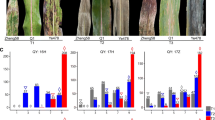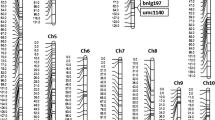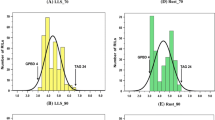Abstract
Breeding maize for gray leaf spot (GLS) resistance has been hindered by the quantitative nature of the inheritance of GLS resistance and by the limitations of selection under less than optimumal disease pressure. In order to identify the quantitative trait loci (QTLs) controlling GLS resistance, a cross was made between B73 (susceptible) and Va14 (resistant) to generate a large F2 population. Six GLS disease assessments were made throughout the disease season for over 1000 F2 plants in 1989, and for 600 F2-derived F3 lines replicated in two blocks in 1990. RFLP analysis for78 marker loci representing all ten maize chromosomes was conducted in 239 F2 individuals including those with the extreme GLS disease phenotypes. The GLS disease scores of the three field evaluations, each averaged over six ratings, were separately used for the interval mapping in order to determine the consistency of the QTL effects. The heavy GLS disease pressure, meticulous disease ratings, and large population size of this study afforded us the sensitivity for detecting QTL effects. QTLs located on three chromosomes (1, 4, and 8) had large effects on GLS resistance, each explaining 35.0–56.0%, 8.8–14.3%, and 7.7–11.0% of the variance, respectively. These three QTL effects were remarkably consistent across three disease evaluations over 2 years and two generations. Smaller QTL effects were also found on chromosomes 2 and 5, but the chromosome-5 effect might be a false positive because it was not repeatable even in the same location. The chromosome-1 QTLs had the largest effect or highest R2 reported for any quantitative trait to-date. Except for the chromosome-4 gene, which was from the susceptible parent B73, the resistance alleles at all QTL were derived from Va14. The resistance QTLs on chromosomes 1 and 2 appear to have additive effects, but those on chromosomes 4 and 8 are dominant and recessive, respectively. Significant interaction between the QTLs on chromosomes 1 and 4 was detected in all three evaluations. Cumulatively, the four QTLs identified in this study explained 44, 60, and 68% of the variance in F2, and in F3 replications 1 and 2, respectively.
Similar content being viewed by others
References
Ayers JE, Johnson MW Jr, Hill RR Jr. (1984) Identifying resistance to gray leaf spot. Proc Annu Corn Sorghum Res Conf, 39th Am Seed Trade Assoc., Washington, DC, pp 157–175
Bubeck DM, Goodman MM, Beavis WD, Grant D (1993) Quantitative trait loci controlling resistance to gray leaf spot in maize. Crop Sci 33:838–847
Donahue PJ, Stromberg EL, Myers SL (1991) Inheritance of reaction to gray leaf spot in a diallel cross of 14 maize inbreds. Crop Sci 31:926–931
Dudley JW, Saghai Maroof MA, Rufener GK (1991) Molecular markers and grouping of parents in maize breeding programs. Crop Sci 31:718–722.
Elwinger GF, Johnson MW, Hill RR Jr, Ayers JE (1990) Inheritance of resistance to gray leaf spot of corn. Crop Sci 30:350–358
Freymark PJ, Lee M, Woodman WL, Martinson CA (1993) Quantitative and qualitative trait loci affecting host-plant response to Exserohilum turcicum in maize (Zea mays L.). Theor. Appl Genet 87:537–544
Huff CA, Ayers JE, Hill RR Jr (1988) Inheritance of resistance in corn (Zea mays) to gray leaf spot. Phytopathology 78:790–794
Johal GS, Briggs SP (1992) Reductase activity encoded by the HM1 disease resistance gene in maize. Science 259:985–987
Lander ES, Botstein D (1989) Mapping Mendelian factors underlying quantitative traits using RFLP linkage maps. Genetics 121:185–199
Lander E, Green P, Abrahamson J, Barlow A, Daly MJ, Lincoln SE, Newburn L (1987) MAPMAKER: an interactive computer package for constructing primary genetic linkage maps of experimental and natural populations. Genomics 1:174–181.
Lincoln S, Daly MJ, Lander E (1992) Constructing genetic maps with MAPMAKER/EXP 3.0. Whitehead Institute Technical Report. 3rd edn
Latterell FM, Rossi AE (1983) Gray leaf spot of corn: a disease on the move. Plant Dis 67:842–847
Manh NQ (1977) Inheritance of resistance to gray leaf spot in maize. MS thesis, Virginia Polytechnic Institute and State University, Blacksburg, Virginia
Paterson AH, Damon S, Hewitt JD, Zamir D, Rabinowitch HD, Lincoln SE, Lander ES, Tanksley SD (1991) Mendelian factors underlying quantitative traits in tomato: comparison across species, generations, and environments. Genetics 127:181–197.
Payne GA, Waldron JK (1983) Overwintering and spore release of Cercospora zeae-maydis in corn debris in North Carolina. Plant Dis 67:87–89
Pe ME, Gianfranceschi L, Taramino G, Tarchini R, Angelini P, Dani M, Binelli G (1993) Mapping quantitative trait loci (QTL) for resistance to Gibberella zeae infection in maize. Mol Gen Genet 241:11–16
Saghai Maroof MA, Van Scoyoc SW, Yu YG, Stromberg EL (1993) Gray leaf spot disease of maize: rating methodology and inbred line evaluation. Plant Dis 77:583–587
Schon CC, Melchinger AE, Boppenmaier J, Brunklaus-Jung E, Herrmann RG, Scitzer JF (1994) RFLP mapping in maize: quantitative trait loci affecting testcross performance of elite European flint lines. Crop Sci 34:378–389
Simcox KD, Bennetzen JL (1993) The use of molecular markers to study Setosphaeria turcica resistance in maize. Phytopathology 83:1326–1330
Stromberg EL, Donahue PJ (1986) Hybrid performance and yield loss associated with gray leaf spot disease. In: Proc Annu Corn Sorghum Res Conf., 41th Am Seed Trade Assoc., Washington, DC, pp 92–104
Stromberg EL, Flinchum LE (1994) Resistance and agronomic characters of corn hybrids under natural gray leaf spot disease pressure, Montgomery Co., VA, 1993. Biol and Cult Tests 1994:87
Stuber CW, Lincoln SE, Wolff DW, Helentjaris T, Lander ES (1992) Identification of genetic factors contributing to heterosis in a hybrid from two elite maize inbred lines using molecular markers. Genetics 132:823–839.
Tanksley SD (1993) Mapping polygenes. Annu Rev Genet 27:205–233
Thompson DL, Bergquist RR, Payne GA, Bowman DT, Goodman MM (1987) Inheritance of resistance to gray leaf spot in maize. Crop Sci 27:243–246
Ulrich JF, Hawk JA, Carroll RB (1990) Diallel analysis of maize inbreds for resistance to gray leaf spot. Crop Sci 1198–1200
Zaitlin D, DeMars SJ Gupta M (1992) Linkage of a second gene for NCLB resistance to molecular markers in maize. Maize Genet Newslett 66:69–70
Zhang Q, Saghai Maroof MA, Kleinhofs A (1993) Comparative diversity analysis of RFLPs and isozymes within and among populations of Hordeum vulgare ssp. spontaneum. Genetics 134:909–91622
Author information
Authors and Affiliations
Additional information
Communicated by P. M. A. Tigerstedt
Rights and permissions
About this article
Cite this article
Maroof, M.A.S., Yue, Y.G., Xiang, Z.X. et al. Identification of quantitative trait loci controlling resistance to gray leaf spot disease in maize. Theoret. Appl. Genetics 93, 539–546 (1996). https://doi.org/10.1007/BF00417945
Received:
Accepted:
Issue Date:
DOI: https://doi.org/10.1007/BF00417945




